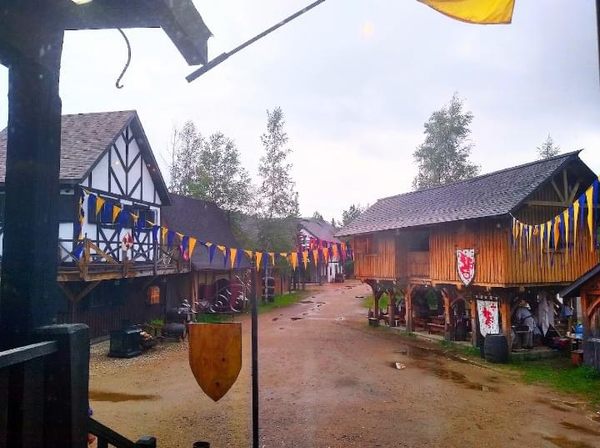About two hours north of Montreal is a surprising village—one that’s quite different from the otherwise sleepy surroundings. Past the occasional Tim Hortons and just outside the town of Trois-Rivières, the road curves deep into the woods. Here, between the trees, visitors will find Tudor manors, Viking-style halls, and a jousting arena. This is Duché de Bicolline, or Duchy of Bicolline, the largest medieval-style settlement in North America—and one that’s still growing, both physically and philosophically.
The Duchy, or just “Bicolline,” as it’s often called, was founded in 1994. The initial focus was on fantasy combat, and the first “Grand Battle” took place two years later, which is still their biggest event. But the live-action role-playing (LARP) game has since expanded into a working medieval fantasy town. Growing from just a handful of structures in the 1990s, Bicolline today boasts over 200 buildings, including a castle, a monastery, an inn, grand halls, and cabins galore, with room for more.
While sites for reenactment events are nothing new, Bicolline’s size and architecture stand out. “It’s been around long enough that the grooves of regular habitation are carved into it,” says Skye Makaris, a living historian at the Ethan Allen Homestead Museum and a member of the Society for Creative Anachronism (SCA)—where she’s known as “Eseld an Gaornic.” “It feels very lived-in, and not like a Potemkin village.”
Bicolline is big enough that the numerous buildings “naturally divide into neighborhoods, with similar housing styles and particular arrangements,” says Makaris. That, along with the regular usage, makes it clear that “it really is a town, not a campsite.”
Like any town, Bicolline has its conflicts.
Bicolline’s original founding as a place for medieval fantasy combat flavored the community that grew around it for years. There has long been a stereotype that reenactment circles, especially combat-centric ones, are heavily white and male, although that’s increasingly changing in recent years—including at Bicolline.
While the changes in the demographics and dynamics have generally been quiet, gradual, and mostly welcomed, in the pandemic-summer of 2020, some of Bicolline’s challenges came to a head.
As the Black Lives Matter movement made headlines across North America, and #MeToo was still fresh in the public mind, the Bicolline community was rocked by an internal rift. Two high-profile influencers in the fantasy LARP world made public statements that they were leaving the Bicolline LARP, citing a culture that was insensitive to women and POC, enabled harassment, and dismissed casual racism.
The impact of their statements was controversial. While some were pleased to finally hear the issues in the community being made public, others felt that these newcomers were speaking out of turn about a group they didn’t fully understand. About a year later, the Bicolline subreddit, which has around 2,000 members, admitted that the Bicolline of the 2010s saw more sexual harassment and less sensitivity. The online community largely agreed that the Bicolline of the 2020s became a different place, with an extensive harassment-prevention policy adopted in 2021.
On the surface, the struggles of Bicolline are quintessentially 21st-century concerns: A community navigates how it defines and deals with internal racism and sexism, and uses social media as their public forum. It all seems a long way from the thatched roofs and royal tournaments Bicolline so painstakingly recreates. But if you look at it from a different angle, the challenges Bicolline faces today are no different from those a town in the Middle Ages might have contended with.
What’s been happening the past few years at Bicolline is the story of a tightly-knit, village-based community facing conflict and deciding how it’s going to proceed in the aftermath of a plague—in this case, COVID-19. And that is as historically authentic as anything the reenactment community could conceive.
The aftermath of the bubonic plague was also a time of social upheaval, according to Harriet Tait, an English historian and one of the leaders behind the restoration of Mint House, a Tudor home in Pevensey, Sussex. “During the Black Death in the 1340s through 1350s, so many people had died,” Tait says. “Because of the feudal system, tenant farmers would pay in their rents, and if the family of the lord was affected, everyone would be affected, and that’s how you would get revolts.”
Pandemics can bring on protests and social transformation for many reasons, says John Firth, author of “The History of Plague—Part 1. The Three Great Pandemics.” The plague wiped out “whole families and villages,” and those losses in Europe “broke down normal divisions between upper and lower classes, and led to the emergence of a new middle class,” says Firth. The surviving members of the working class found their labor in demand. This shift in the social order led to an opportunity for those who had previously been marginalized to make demands and be heard.
Such social upheavals could partly explain why some Reddit users noted how “the pandemic, and the time it allowed [Bicolline] to restructure,” and “BLM protests in Quebec” brought transformation to the community.
It’s not just the social structures that face the question of change versus preservation, but the building structures as well. Though Tait, the historian, has never been to Bicolline, she understands the challenges of keeping historic architecture intact for modern needs. In restoring Mint House for public use, Tait has had to be mindful of safety concerns that the home’s original builders would never have considered. Like the reenactors of Bicolline, she’s had to consider where to compromise at the intersection of history, space, and the needs of guests.
British laws around historical preservation mean that Tait and the Mint House team need to ensure authenticity in ways that would make the SCA proud. “Because we’re a listed building, we can’t put a nail, even, into the beams. To hang things, we have to find an existing nail hole!”
Even that raises its own questions—like what is “historical authenticity” anyway? Mint House struggles to answer. “There are some early 20th-century additions to the house. They’ve built an extra room in the Great Hall, and you can’t get from one room to another without a bottleneck,” Tait says. But whether to modify the alterations is still an unsettled question.
Such a mishmash of history exists at Bicolline, as well. Tudor-style halls are separated by 500 feet and 500 years of architectural history from nearby Viking-inspired structures. All the buildings in Bicolline appear to span several centuries, their facades seeming to say that authenticity is in the eye of the beholder. The Bicolline website makes it clear that while they have period-appropriate rules of decorum (including a ban on visible cell phones), costuming, and architecture alike can take inspiration “from the Middle Ages, to the Renaissance, and up to the 17th century,” as well as fantasy media.
It’s perhaps this attitude of taking from history what you love—but leaving behind what you don’t—that will carry Bicolline forward. In the Middle Ages, villages adapted in ways that changed their physical landscape. “When you see a medieval church all alone in a field, that was invariably a village,” Tait says. When the Plague hit, the town would “literally pack up their belongings and move a few miles away, where it’s safe.”
The physical changes to Bicolline are subtler. New cabins crop up, with new inhabitants bringing their own visions. The main LARP shares its space with other events, like the SCA festival Makaris attended. Per the Bicolline subreddit, a guild of self-proclaimed “bad guys” was forced to remove an offensive flag. And the community grows.
Today, Bicolline describes itself as bound by seven key values: cooperation, sustainability, game ethics, involvement, inclusion, respect, and civic responsibility. These form what you could call Bicolline’s chivalric oath, which they can turn to in times of conflict or struggle. Just as Ramon Llull in the 13th century outlined seven Christian virtues—faith, hope, charity, justice, prudence, temperance, and fortitude—for knights to live by in his Book of the Order of Chivalry, Bicolline has adopted the code for a modern audience, and for knights who are sworn to leave their opponents intact after combat.
Makaris returned to Bicolline in the summer of 2024 for “the Beltaines,” a combat tournament event that also included art classes and a show of handmade costumes and tools. And in Bicolline’s real-yet-imagined place out of time, the thatched halls are ready for feasting and fighting through a brand-new day.


